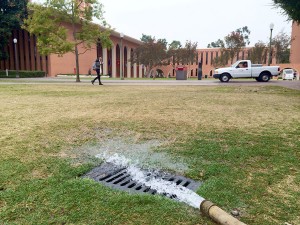Drought affects campus water usage
On Tuesday, Oct. 14, Los Angeles Mayor Eric Garcetti issued an executive directive on water conservation to address the increasing severity of the drought in California.

Leakage · Facilities management waters lawns before 7 a.m. to reduce water waste from evaporation as part of USC’s sustainability program. — Mac McDonough | Daily Trojan
The directive outlined three main goals: reduce fresh water use by 20 percent by 2017, reduce the Department of Water and Power’s purchase of imported water by 50 percent by 2024, and create an integrated water strategy.
California has been severely affected by the recent drought. Lawmakers have reached a new water bond deal that will be on the Nov. 4 ballot for voters, and Gov. Jerry Brown has requested Californians to reduce their water consumption by 20 percent, according to the Sacramento Bee.
According to the USC Sustainability Office website, USC has significantly reduced water consumption on campus since 2007.
There are currently several water conservation programs at USC. One of these programs, Facilities Management Services’s campus-wide water management system, is designed to reduce water usage. One measure of this system is watering the grass before 7 a.m. to minimize evaporative loss. Moisture sensors monitor the soil to manage irrigation schedules. In addition, Auxiliary Services has installed low-flow showerheads, toilets and efficient washing machines in on-campus housing.
Along with these environmentally friendly measures, there are multiple environmentally-oriented student groups on campus. The Environmental Student Assembly, a branch of Undergraduate Student Government, is one such group focused on environmental and sustainable initiatives.
ESA will soon be launching a university-wide campaign to cut water consumption. The implications of the fountains, pressure washing of sidewalks, and sprinkler use will be addressed.
USC has also formed a “Water Conservation Task Force,” of which Shawn Rhoads, Executive Director of ESA, is a member. “Some objectives of the task force include establishing an accurate water consumption baseline, a reduction target for consumption, and an educational campaign,” he said in an email.
Yet there is still concern over USC’s water consumption when it comes to lawn and plant watering and the numerous fountains on campus.
“ESA believes that the university has a long way to go in terms of water conservation. We hope to voice our opinions and concerns through the Water Conservation Task Force,” Rhoads stated in an email.
There are 29 USC fountains and counting, as there will be a new one built in the USC Village set to be finished in 2017 according to USC News.
“I think the one thing a lot of people forget about the fountains is that they’re using fresh water,” said Jinny Choi, the director of university outreach for ESA. “It’s water that, without the chemicals, could have been used.”
She said that the university places importance on the aesthetic appeal of campus through the numerous lawns, plants and fountains on campus.
“One of the biggest complaints is that we have to pay USC to turn off their sprinklers and fountains whenever we have an event going on, which is really weird because we have to pay them to conserve water,” Choi said. “We’re using so much water for the aesthetic view.”
Choi hopes to see a community across all organizations on campus advocate for more sustainable practices.
“You can’t just dump the responsibility onto one organization,” Choi said. “This is a leading university and as a university that’s in Southern California, I think we should be more aware of our geographic problems and community.”
Editor’s note: story has been updated to include more information from members of the Environmental Student Assembly.

